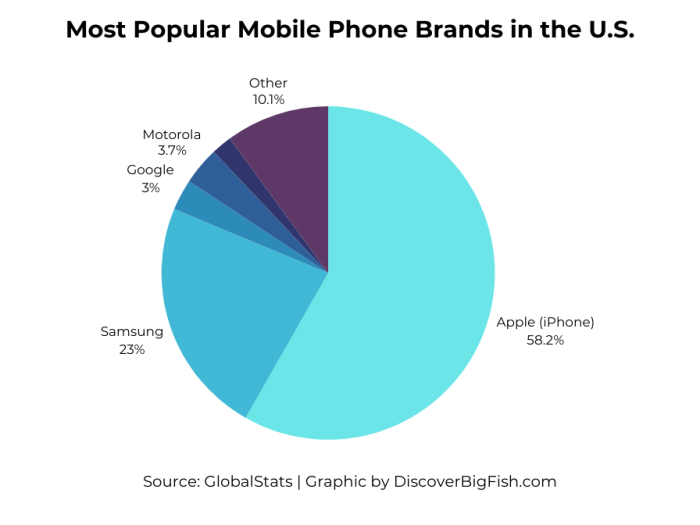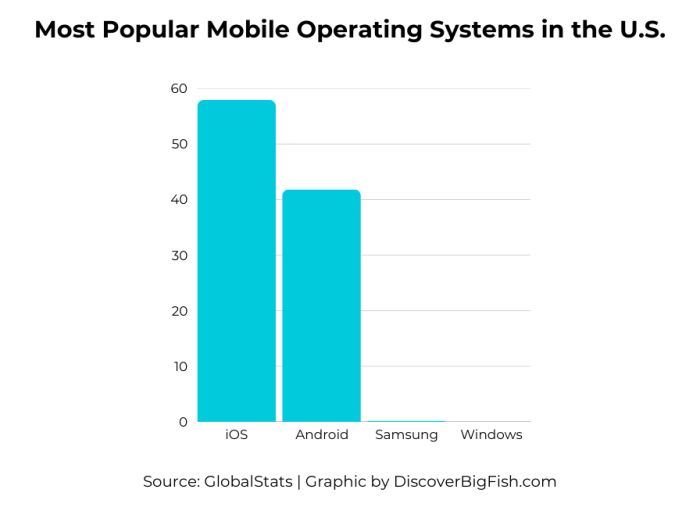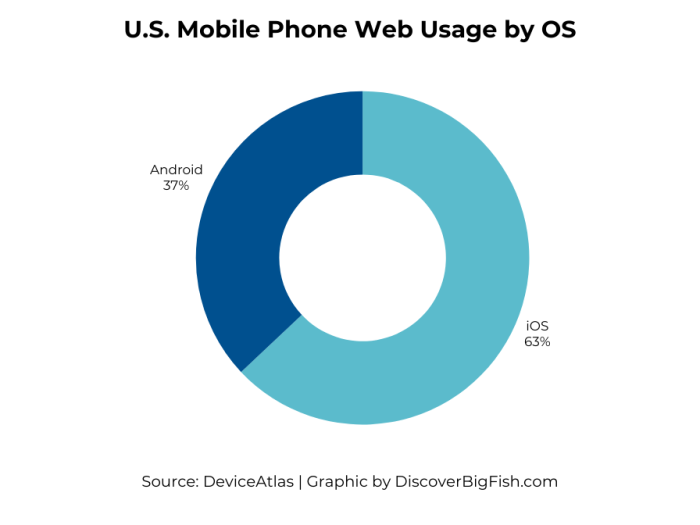For companies looking to develop mobile apps, knowing which mobile phone platforms are most popular can provide key insights into reaching the largest possible audience.
With smartphone adoption skyrocketing – 90% of U.S. adults now own a smartphone, compared to just 35% in 2011 (Statista) – the landscape has evolved rapidly.
In the U.S., Apple and Android lead, controlling almost the entire smartphone market. But within this duopoly, there are some differences in brand preferences and user behavior.
This article explores the most popular mobile phones in the United States for 2025 to help you make informed decisions about your next app development project.
Most Popular Mobile Phone Brands in the U.S. (2025)
- Apple (iPhone) 58%
- Samsung 23%
- Motorola 4%
- Google 3%
- Xiaomi 2%
- Others (i.e. Unknown, Huawei, Vivo) 10%
(Source: GlobalStats)
As the numbers indicate, Apple’s iPhone is the most popular mobile phone brand with more than half of the U.S. market share.
Samsung, despite being the leading Android brand, commands less than half of Apple’s share, while brands like Google, Motorola and Xiaomi maintain only a modest presence.
What’s noteworthy here is that Apple’s dominance comes despite the wide variety of mobile phones available across all these other brands.
Most Popular Mobile Operating Systems in the U.S. (2025)
When you shift focus from hardware to operating systems, the picture remains largely the same.
Apple’s iOS leads with a 58% share, while Android trails at 42%.
- iOS 58%
- Android 42%
- Samsung 0.22%
- Windows 0.02%
(Source: GlobalStats)
These figures have been relatively stable for the past five years. But it’s interesting to note that before 2018, Android was actually the dominant mobile operating system in the U.S.
The reason? Android’s operating system was (and still is) used across multiple brands like Samsung, Google, and LG, offering users a range of choices at various price points.
However, over time, Apple has edged ahead, solidifying its place as the preferred choice for U.S. users.
Mobile Phone Web Usage
If you’re developing a mobile app, understanding the differences between mobile phone ownership and web usage is crucial.
While market share statistics give a general sense of mobile phone ownership, they don’t fully reflect the number of smartphone users – the segment that can actually download and use apps.
Many Android devices included in the above market share numbers will be older or simpler models, like flip phones or feature phones, which cannot install apps.
Phones that are capable of browsing the internet are almost always smartphones – and therefore, app-capable.
This is where web usage comes in as a key indicator. Phones that are capable of browsing the internet are almost always smartphones – and therefore, app-capable.
U.S. Mobile Phone Web Usage by OS (2025)
- iOS 63%
- Android 37%
(Source: DeviceAtlas)
This breakdown shows that iOS is the dominant platform among smartphones that are actively engaging with the web.
This suggests that, if you’re an app developer, focusing on iOS will give you access to an even larger pool of active smartphone users in the U.S., compared to Android.
Final Thoughts
For businesses and developers, understanding the mobile phone market in the U.S. is essential when deciding which platform to prioritize.
With Apple commanding the largest market share in both hardware and web usage, iOS should be a key focus for app development targeting U.S. consumers.
However, Android’s significant presence and diverse range of devices shouldn’t be ignored, especially if you’re aiming to capture a broader or more price-sensitive audience.
Ultimately, staying informed about market trends and web usage data can help you tailor your app development strategy to better align with your target users.
Whether you choose to prioritize iOS, Android, or both, making data-driven decisions will ensure that your app reaches the right users and drives success for your business.









